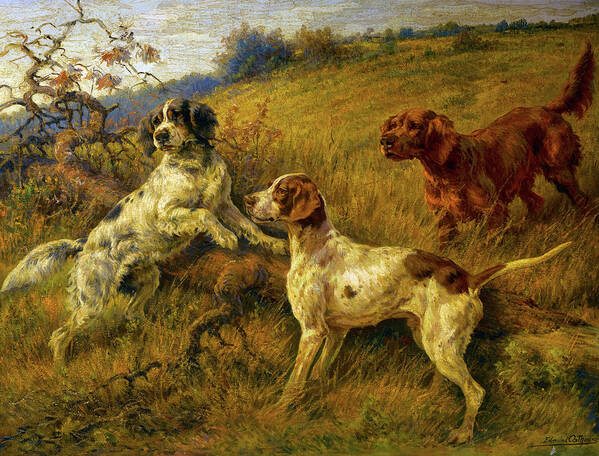
One might not think there would be working similarities between two different sporting breeds, one that traditionally crouches, and one that traditionally points, but the phrase, “high on both ends” is often mentioned in the context of both American-bred English Setters and Pointers that work in the field.
In such a stance, the dog stands with its head and tail held high (or, put another way, close to, or right at 12 o’clock), a characteristic some expect in American field trials for bird dogs. It’s possible that this is favored because it is associated with a confident and alert dog. Pointers are already known for their “stand tall” posture, and many are trained to be, “steady to wing and shot,” a position that allows a hunter to get off a clear shot.
Traditionally, English Setters, described by some as America’s first bird dog (though the breed was originally developed in England), were bred to crouch low to avoid entanglement in nets during hunting, but with the advent of firearms in hunting, the modern “high on both ends” became more desirable. As with the Pointer, the posture demonstrates a dog’s alertness and readiness to locate game birds while allowing the dog to maintain a clear line of sight and scent – crucial for effectively locating and pointing out birds to a hunter. While some find this visually impressive and functional, we suspect such Setters would not ribbon in a show ring.
In other parts of the world, “high on both ends,” isn’t, as they say, “a thing.” In Europe, setters are still expected to crouch on point, locate the scent of a bird and then attempt to get as close as possible much as a predator would stalk a deer. Another term for this strategic behavior is “roading their bird,” and hallmarks of doing it right include a dog who moves with purpose and intention, pausing occasionally as the scent of a bird is tracked; a head held high ears twitching, his or her body shifting to “relocate” and move closer to the moving bird, and finally, eyes that are laser-focused, a sign of a successful roading effort.
As always, we defer to the wisdom of people who actually hunt with either breed, but when we find verbiage unique to a couple of field breeds (“High on Both Ends” and “roading a bird”), we want to share.
Image: “Setters and a Pointer in a Landscape” by Edmund Henry Osthaus (1858 – 1928) is shared under the pubic domain
